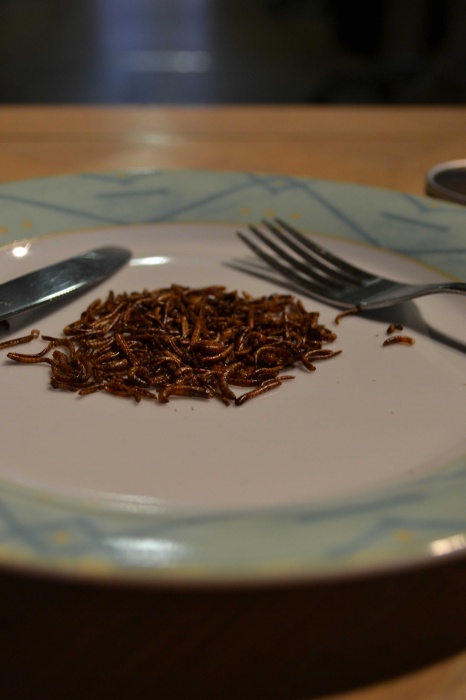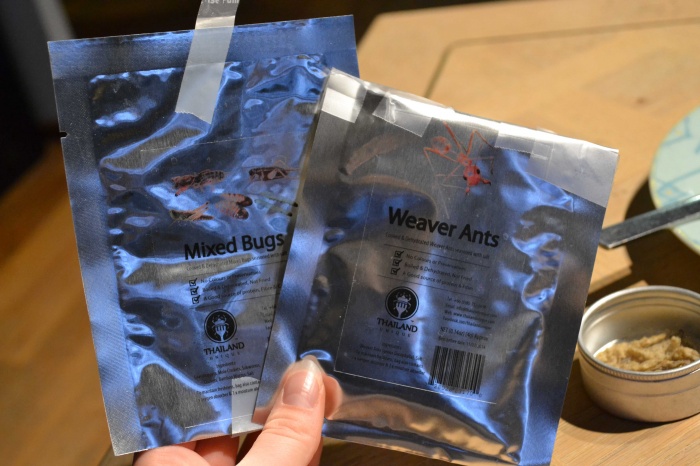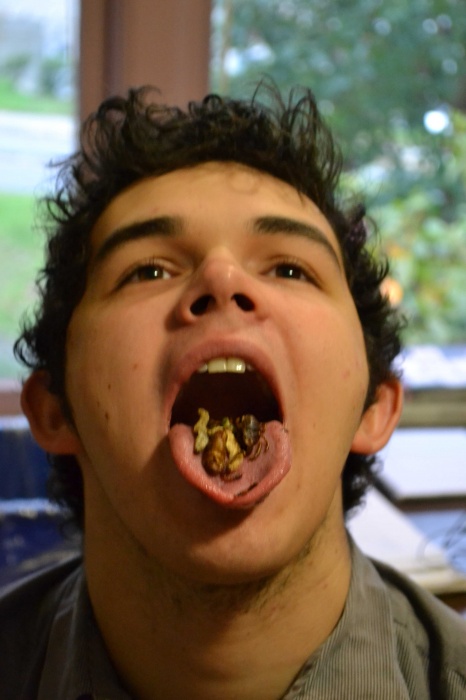I tried them for the first time just the other day.
Some might call me a brave pioneer, but it was simply a matter of doing my duty. It was shocking how calm I felt. There was little to no adrenaline; there was no fear. I wasn’t even phased by my onlookers, cringing in horror.
I didn’t hesitate… I put the worms in my mouth and chewed.
They were extra crunchy and I could feel them getting lodged in my teeth like poppy seeds. It was the first time I had ever thought of them as food. Crickets, ants, some kind of weird grub: I tried them all.
They went down easy. Delicious.

Protein is important. Humans are omnivores, and we can benefit from the essential amino acids that are most easily absorbed from meat proteins. Nonetheless, the amount of meat North Americans are consuming is almost as large as the average waistband.
This is not a hidden fact: people have known this for years. It’s just in the past couple decades that more people have started to care, and this has brought about a great search for alternatives.
The average North American consumes just shy of 200 pounds of meat a year, an amount which many educators and activists think is way too high.
“That is a tremendous amount, and we’re actually realizing now that we are not designed to support that level of meat consumption. It’s really hard on our hearts and it’s hard on our health,” explains Nicole Kilburn, an anthropology teacher at Camosun.
But what if there were a protein alternative out there that few of us in North America have even considered? They’re creepy and crawly, but they actually taste pretty good. We’re talking about bugs, of course!
“Insect protein has all sorts of things going for it, but one of them is the nutrition piece,” explains Kilburn. “It’s a much healthier source of protein for the human body. Insects are low-fat and really high in protein, iron, and calcium.”
This, to many, may sound like something so farfetched that they have never deigned to consider it, but entomophagy, or the consumption of insects, is no phenomenon to most of the world. Despite its massive popularity around the planet, Western culture has labelled the activity of eating insects taboo. This may have been satisfactory in the past, but with the food problems of today it’s unlikely that the label will stand for very long.
And although it’s quite likely that someday bugs might be a staple of the North American kitchen, Kilburn suggests our ignorance of this possible food source is because of a very practical reason.
“One of reasons why western culture doesn’t eat insects is because of geography,” she says. “There simply aren’t an awful lot of big, plentiful insects for us to traditionally have consumed. Though shellfish have been a really important part of the diet in coastal communities for a long time, and things like shrimp and prawns are actually so similar to crickets and grasshoppers that if you have an allergy to one, you probably have an allergy to the other.”
Though there are some who choose not to eat shellfish, there are many who eat it without a second thought. The question then arises, if they are so similar, why one and not the other? It all comes down to point of reference. There are many cultures that look at some of our food traditions and gag, after all.
Culture shocker
Kilburn suggests that the ew factor of eating bugs is just a response to something that we’re not used to yet, but that it’s no different than some of the other animal products in most North Americans’ diets.
“It’s normalized that in North America you consume a lot of milk and you don’t necessarily think about that,” says Kilburn. “I had a professor at the University of Colorado who did some work in South America. She recollects telling people about drinking milk and they were dry heaving. What they said was, ‘Let me get this straight. You actually drink the bodily secretions from another animal’s giant sweat gland. You drink something that comes out of this other species?’ And when it’s put like that, you think, ‘Wow, that is a bit odd.’ Yet we have completely normalized it, and it’s something that we celebrate and have identified as part of a normal diet.”
This same idea applies to western culture in many ways. In Scotland, they eat haggis, and there are many here who find that gross. Sheeps’ eyes, frogs’ legs, snake soup, and snails are all foods that are eaten without gagging in other parts of the world.
But here we have decided that those foods are unpleasant without so much as tasting a morsel. Kilburn puts it well when she says that we have determined what is edible based more on culture than on our taste buds.
Insects have long been an important part of food cultures from around the world, she says. While it’s certainly very foreign to modern western diets, there are over 2,000 species of edible insects that have been consumed in 80 percent of the world’s cultures. We are, in fact, the outsiders when it comes to bug consumption. Perhaps the time has come for our culture to reconsider its present position?
“We are starting to realize that our affluence is unsustainable in so many ways. Our consumption pattern of all of the resources on this planet, whether it’s making cheap clothing, fuelling our vehicles, the way that we use water, the way that we waste food, or the way that we bring food in from all over the world, is incredibly difficult on our environment,” explains Kilburn. “There was a report that came out last month that identified that if all humans lived the way that North Americans do we would need the equivalent of four planets to be able to support our demands.”
Eat bugs and save
Consuming insect protein offsets demands in other parts of the ecosystem. If one consumes insect protein, they are placing less demand on other sources of traditional protein.
Next Millennium Farms, a government-inspected insect farm located in Ontario, has found that if a family of four ate insect protein one day a week, in the course of a year that family could save 650,000 litres of water, just from one meal out of seven.
“Our traditional sources of protein, particularly cattle, are incredibly hard on the environment. They use tons of acreage, huge amounts of water, lots of fossil fuel inputs in terms of feed, and fertilizer for that feed, and their nutrient conversion isn’t great. Cows are kind of the SUVs of our food system,” says Kilburn. “Insects, on the other hand, are environmentally sustainable. They’re swarming creatures, so you can grow them in very large densities without taking up a huge amount of space, and it’s still humane. They use a fraction of the amount of water, they produce a fraction of the greenhouse gas emissions, and they don’t produce ammonia or methane, which contribute to the degradation of soils and dead zones in the oceans. So insects have the environmental argument sewn up, in my opinion.”

Not only do crickets require a fraction of the inputs of large protein sources, but their ability to multiply is amazing. A female cricket can produce more offspring than a cow or chicken, and they then mature within four to six weeks. With a turnaround that high, crickets are set to provide a healthy, environmentally sustainable source of protein for the hungry masses. This option couldn’t have appeared soon enough.
“I think that there are many people of my generation and younger that are thinking much more critically about our impact on the planet,” says Kilburn. “Starting to think about how they address climate change, soil degradation, deforestation, there’s an awakening that is happening. Part of the reason that I wanted to get involved is that there needs to be a viable option. It’s really hard to tell students about all of the terrible things that are happening that we as human beings have a hand in, and not having a viable alternative.”
The next generation of farms
Luckily, the upswing in insect-protein-related interest in the past few years has presented an alternative for at least some of those problems.
Next Millenium saw this as an opportunity to go from mainly providing crickets for the reptile trade to providing insects for human consumption. After moving to a 5,000-square-foot industrial property and advancing some of the technology associated with the raising and processing of insects, they began selling to the public. Though the going was slower at first, business picked up, and Jarrod Goldin, one of the farm’s founders, says that sales this most recent month were 164 times the sales of six months ago.
“You could say the curve is beginning to slacken now, but that’s simply because we are reaching our capacity,” says Goldin. “We are in the process of raising funds, of getting a significant investment that will allow us to really try and expand our company and grow into some of the demand.”
Being a kind of pioneer in a new field of production has created some unique opportunities for Next Millennium. Not only have the sales of product been phenomenal, but they have also received lots of interest from others who would like to use their technology to start their own farms.
Though the crickets, mealworms, and other varieties of bugs raised by the farm are considered livestock, Goldin says that they have little in common with beef or pork.
“It’s far more akin to corn than meat because meats don’t have the same pharmaceutical applications or industrial applications,” he says. “This commodity, and I think it will be traded on the stock market like orange juice and coffee, is much more like corn in the sense that corn’s industrial. They are looking into using chitin [found in insects’ exoskeletons] when they paint the inside of oil tankers, because it acts as an anti-corrosive. There are applications in wound-healing with band-aids made out of chitin, and on people who get massive wounds that are difficult to stitch. There are pharmaceutical applications for shampoos, or shampoos for dogs’ coats, or B12 extraction for B12 pills, and that’s just to name a few. Obviously the adoption in those different areas will be hard to predict, but I can tell you with the internet, social media, the issues with food transparency, and people learning about where their food comes from, this as a source of nutrition is very attractive.”
Verrry interesting
And the interest in bug consumption does seem to be there, but at the moment the market has problems with education and accessibility. Either most people are unaware of the benefits of insect protein, or they simply don’t have the means to obtain any bugs for the dinner table. Time will be the biggest factor in both cases as word gets out and more farms begin to appear. In the meantime, those who are educated in the matter seem very willing.
“I would consider eating insects as a good form of protein,” says Sarah Lindsay, a Camosun student in the second year of the accounting program. “They are animals, there’s lots of them, so a ready supply. Though it’s not my first choice, as I like the fleshy texture of chicken.”
Although she’s still a bit weirded out by the prospect of eating bugs, Lindsay realizes that it’s probably just a case of mind over matter, and that insect consumption is no different from eating other kinds of animals.
“I’ve grown up being told that eating insects is not the norm, and so I find the idea slightly repulsive,” says Lindsay. “Which makes me sad, because I feel like I’m missing out on some great opportunities.”
Even those who wouldn’t personally eat bugs seem to see it as a cultural possibility. Hayley Langdon, a Camosun student in office administration, says that if she wasn’t a vegetarian and did, in fact, eat meat, she would likely try eating insects, as they’re not really different from other animals.
Kilburn suggests that the easiest way for people to adapt to eating bugs is simply to take the plunge and try it.
“Cooking crickets was quite an adrenaline rush,” she says, “and it was quite hard the first time. What was amazing was that once it became food, it was just fine, and once you get it past your mouth you can think about it in a very different way.”
Live and learn
The transition from creepy crawly to actual food will be one of the hardest parts of the adoption of insect protein into people’s diets. Kilburn says that education about the benefits of bug consumption is critical, so from 7 to 9 pm on Wednesday, November 26 in Young 300 on the Lansdowne campus, students from Anthropology 204, a Camosun course on the anthropology of food, will be doing a public education event to promote a conversation about insect protein as a sustainable component of food in the future (tickets, $8, can be purchased from Kilburn).
“There’ll be samples, and each student is going to do either an interactive poster or a booth,” says Kilburn. “It’ll be set up so you move from booth to booth and learn about the different element of insect protein, whether it’s how to do micro livestock rearing in your own home, what the introduction is going to look like, comparing and contrasting what the product is going to look like, or talking about the psychology of introducing a taboo food into the Western diet.”
This “pestival” will provide a unique chance that has so far been unavailable in our corner of the globe. Millennium Farms and a company called Tiny Farms out of California have generously provided plenty of content to help introduce the public to a wide variety of insect-related products.
“It’s going to be as diverse as possible with lots of opportunities for people to try it out,” says Kilburn. “It’s going to be a lot of fun. We’re hoping it will be a really robust blend of students and members of the public that want to learn about new sources of protein.”
For the planet’s sake
The entomophagy movement is here to stay. Some have estimated that within the next five years people will be consuming insects on a regular basis.
Emily Pendergraft, manager of the Victoria Bug Zoo, suggests that everyone will soon see the benefits.
“I’m a vegetarian. I’ve been one since I was born, so the only meat I’ve ever eaten is bugs. And I actually accept that because it’s better for the planet and is a better source of protein for our bodies,” says Pendergraft.
The bug zoo has been open for nearly 18 years, but it’s only in recent times that Pendergraft has really seen people considering insects as a viable food option. Though they stock many novelty items, including energy bars made of crickets, she can’t wait to stock more insect protein products. At this point, it’s really only a question of finding more suppliers, then waiting.
“We do get a lot of people who are very interested in it, and interested in the cookbooks we sell and that sort of thing. But a lot of people can’t believe it, actually. It’s very strange. A lot of people just don’t understand that you can eat bugs, so we’re trying to change that,” says Pendergraft. “I don’t think anyone was talking about it 10 years ago, and if they were I don’t think anyone was listening. Now people are actually listening. I hope that North America gets on board, for the planet’s sake.”

But… how do they taste?
At a recent taste test in the Nexus offices, I tried three different types of insects. To help give a better idea of what exactly it’s like to eat insects, here are my tasting notes.
Mealworms
The mealworms were super tasty. They were seasoned a bit, but underneath you could really taste a kind of nice, nutty flavour. I’m told they go nicely on tacos (seriously!).
Ants
The ants I didn’t like so much, because I’m terrified of ants, and their texture was a little bit stranger. Despite that, they did taste kind of lemony, which wasn’t half bad.
Crickets
I also had a cookie that had cricket powder added to it, which can be thought of as a kind of protein powder. It mostly tasted like a cookie, but there was kind of that same nuttiness underneath, which, if anything, added to the flavour.
